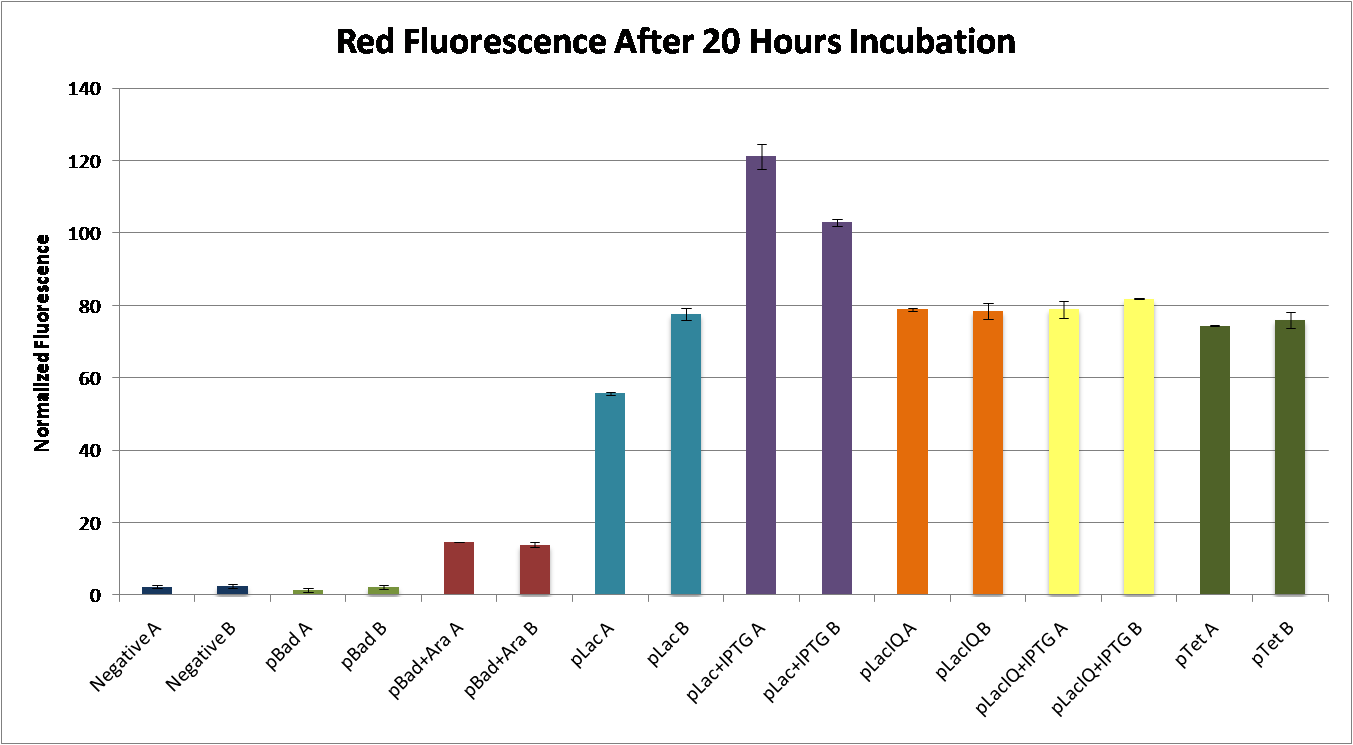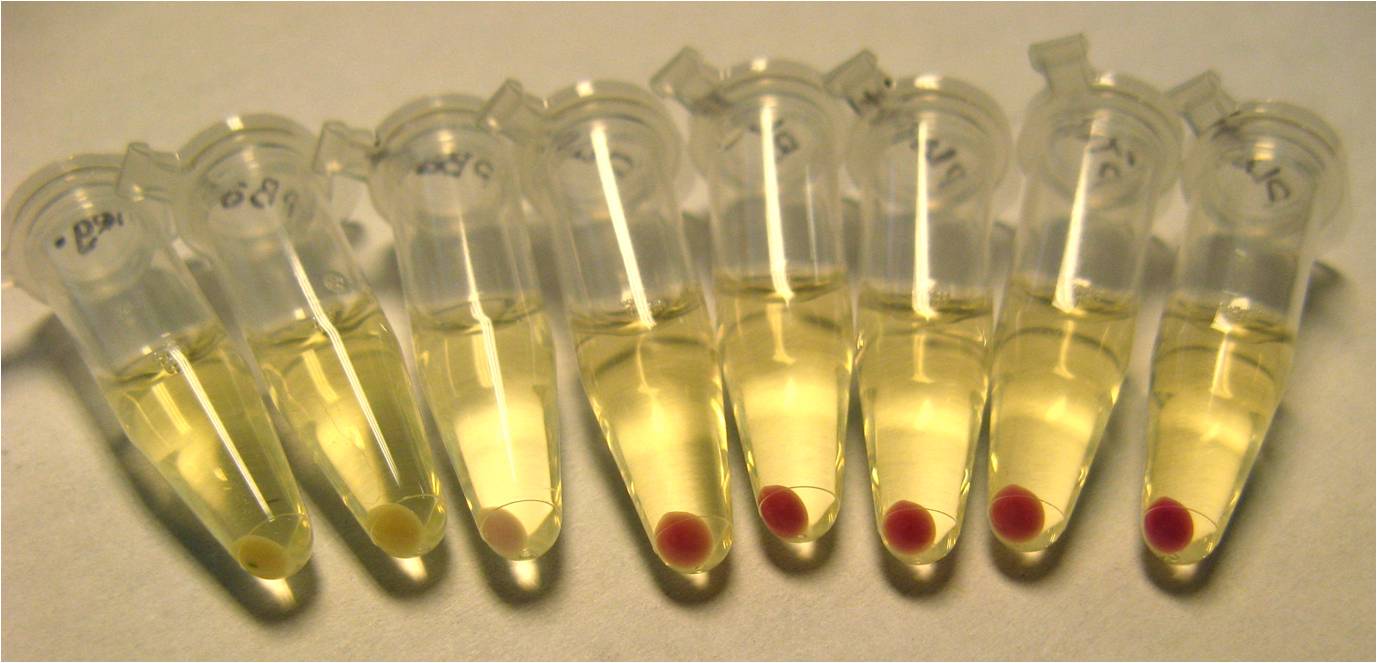Team:MoWestern Davidson/project wetlab
From 2009.igem.org

Contents |
Completed tRNAs
We assembled the genes for our suppressor tRNAs by ligating single-stranded oligos with sticky BioBrick ends. This generated double-stranded DNA ready to ligate into a standard vector. All tRNAs bring the same amino acid, serine. The expected size of our tRNAs with BioBrick ends is 184 bp. Below is a 2% agarose gel of plasmids containing our tRNA insert, digested with EcoRI and PstI:
For controlling our suppressor tRNA expression, we wanted a promoter that would transcribe enough tRNA to cause a high probability of suppression but not so much tRNA that cells would become sick. We decided to use a constitutive weak-medium promoter, pBad, to express our suppressor tRNAs.
This promoter choice allows us to induce greater expression with L-arabinose. We found that suppressor tRNAs controlled by pBad is not lethal to E. coli and allows for normal culture growth.
Successfully Assembled tRNAs
| Codon | Anticodon Sequence |
|---|---|
| AGGAC | CUGUCCUAA |
| CGGUC | UUGACCGAC |
| CUACC | GUGGUAGAA |
| CUACU | UUAGUAGAU |
| CUAGC | CUGCUAGAA |
| CUAGU | UUACUAGAC |
| CCAAU | CUAUUGGAC |
| CCACC | UUGGUGGAA |
| CCACU | CUAGUGGAC |
| CCAUC (9-bp anticodon) | GUGAUCCAA |
| CCAUC (10-bp anticodon) | UUUGAUGGAG |
| CCCUC | CUGAGGGUC |
Completed Reporters With Frameshift Suppressor Leaders
In order to engineer logical clauses directly upstream of our selected reporter genes, we altered the 5’ end of the reporter using PCR to add frameshift suppressor leaders (FSLs). FSLs were added after the reporter start codon ATG so that the suppressor tRNAs are required to correctly translate the entire reporter. We began with a modular 1-SAT approach - adding a single 5-nt codon as the FSL to the 5' end of the reporter.
Successful FSL Additions
| CUAGC (Leu3) | --- | --- |
| --- | CUAUC (Pro4/Pro5) | --- |
| --- | CGGUC (Arg2) | CGGUC (Arg2) |
| --- | CUACU (Leu2) | CUACU (Leu2) |
| --- | CUAGU (Leu4) | CUAGU (Leu4) |
| --- | CCCUC (Pro6) | --- |
The PCR template for our FSL additions were reporter constructs with a promoter and RBS. For example, pLac-RBS-RFP was the template plasmid for the FSL-RFPs. This was helpful after PCR and ligation into the template vector, so that we could select potential FSL-RFPs by colour selection.
Below is a plate of colonies transformed with our potential FSL-RFPs. Red colonies clearly have the original construct since they still express RFP in the absence of the appropriate suppressor tRNA. White colonies potentially have our desired construct.
Selected colonies were sequenced for verification of the correct FSL addition. The next step is to ligate each tRNA with the corresponding FSL-reporter, so that both genes will be present and expressed within the cell. We are attempting two possible constructs for this:
1.The tRNA controlled by a separate promoter from the reporter.
2.The tRNA directly downstream of the reporter.
Choosing A Promoter
One important consideration in our project design was choosing the promoter(s) that would induce a notable phenotype from our reporters. For controlling our reporters with a leading logical clause, we wanted a promoter that would have strong enough transcription to allow more chances for suppression, and thereby more reporter expression.
Promoter Control of Fluorescence Reporters
In order to have a visible expression of RFP or GFP, we constructed parts with RBS-RFP under the control of 4 different commonly-used promoters:
- pBad (Potential induction with L-arabinose)
- pLac (also called pLacI. Potential induction with IPTG)
- pLacIQ (Potential induction with IPTG)
- pTet
We found that pLac induced with IPTG caused the greatest expression of RFP. This construct, pLac-RBS-RFP, was chosen as our control construct, representing 100% suppression of the engineered frameshift.
Promoter Control of Drug Resistance Reporters
Previous experiments in our lab showed that controlling tetracycline resistance with pLac+IPTG made cells sick. Therefore, we were cautious in choosing a promoter that would be compatible with the tetracycline resistance gene. This gene is tricky to work with because expressed at certain levels, it has the potential to make a cell sick. The tetracycline resistance gene encodes a cytoplasmic membrane protein that actively pumps tetracycline out of the cell in order to reduce intracellular concentrations.
There are two disadvantages to using tetracycline resistance: 1) the protein it expresses is energy-dependent and 2) it creates holes in the cell wall. Both of these characteristics can be lethal if expression is not properly regulated.
In order to demonstrate the expression of tetracycline resistance, we constructed parts with RBS-Tet under the control of the following 2 promoters:
- pBad (Potential induction with L-arabinose)
- pLacI (also called pLac. Potential induction with IPTG)
- pLacIQ (Potential induction with IPTG)
- pTet
We grew each construct on both ampicillin resistant-plates and tetracycline resistant-plates with a couple goals in mind:
- to test which promoter helps produce the most Tet resistance
- to test whether or not cells with the Tet resistance gene were more likely to survive under selection pressure
 "
"










